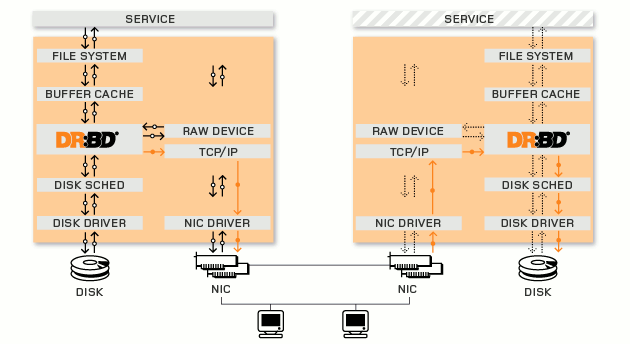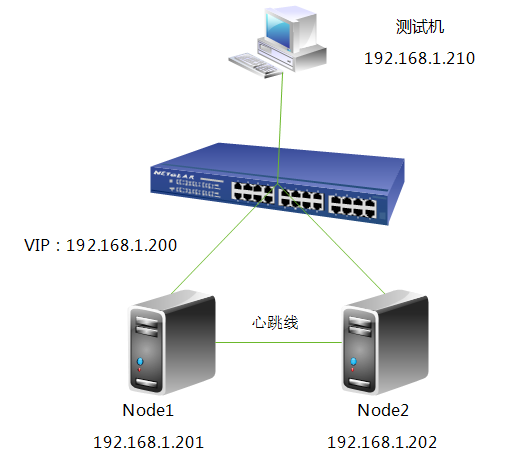-
协议A:异步复制协议。本地写成功后立即返回,数据放在发送buffer中,可能丢失。
-
协议B:内存同步(半同步)复制协议。本地写成功并将数据发送到对方后立即返回,如果双机掉电,数据可能丢失。
-
协议C:同步复制协议。本地和对方写成功确认后返回。如果双机掉电或磁盘同时损坏,则数据可能丢失。
-
drbdadm:高级管理工具,管理/etc/drbd.conf,向drbdsetup和drbdmeta发送指令。
-
drbdsetup:配置装载进kernel的DRBD模块,平时很少直接用。
-
drbdmeta:管理META数据结构,平时很少直接用。
-
Resource name:可以是除了空白字符的任意的ACSII码字符
-
DRBD device:在双方节点上,此DRBD设备的设备文件;一般为/dev/drbdN,其主设备号147
-
Disk configuration:在双方节点上,各自提供的存储设备
-
Nerwork configuration:双方数据同步时所使用的网络属性
|
1
2
3
4
5
6
7
8
9
10
11
12
13
14
|
resource web {
#资源名为“web”
on node1.magedu.com {
#设置节点cluster1
device
/dev/drbd0
;
#指出drbd的标示名
disk
/dev/sda5
;
#指出作为drbd的设备
address 172.16.100.11:7789;
#指定ip和端口号
meta-disk internal;
#网络通信属性,指定drbd的元数据在本机
}
on node2.magedu.com {
device
/dev/drbd0
;
disk
/dev/sda5
;
address 172.16.100.12:7789;
meta-disk internal;
}
}
|
-
一个磁盘,或者是磁盘的某一个分区。
-
一个soft raid 设备。
-
一个LVM的逻辑卷。
-
一个EVMS(Enterprise Volume Management System,企业卷管理系统)的卷。
-
其他任何的块设备。
-
安装drbd
-
配置资源文件(定义资料名称,磁盘,节点信息,同步限制等)
-
将drbd加入到系统服务chkconfig --add drbd
-
初始化资源组drbdadm create-md resource_name
-
启动服务 service drbd start
-
设置primary主机,并同步数据
-
分区、格式化/dev/drbd*
-
一个节点进行挂载
-
查看状态
-
CentOS 6.4 X86_64
-
kmod-drbd84-8.4.2-1.el6_3.elrepo.x86_64
-
drbd84-utils-8.4.2-1.el6.elrepo.x86_64
|
1
2
3
4
5
6
7
8
|
[root@node1 src]
# wget http://download.fedoraproject.org/pub/epel/6/x86_64/epel-release-6-8.noarch.rpm
[root@node1 src]
# rpm -ivh epel-release-6-8.noarch.rpm
warning: epel-release-6-8.noarch.rpm: Header V3 RSA
/SHA256Signature
, key ID 0608b895: NOKEY
Preparing...
########################################### [100%]
1:epel-release
########################################### [100%]
[root@node1 src]
# rpm --import /etc/pki/rpm-gpg/RPM-GPG-KEY-EPEL-6
[root@node1 ~]
# rpm -ivh http://elrepo.org/elrepo-release-6-5.el6.elrepo.noarch.rpm
[root@node1 ~]
# yum list
|
|
1
2
3
4
5
6
7
8
|
[root@node2 src]
# wget http://download.fedoraproject.org/pub/epel/6/x86_64/epel-release-6-8.noarch.rpm
[root@node2 src]
# rpm -ivh epel-release-6-8.noarch.rpm
warning: epel-release-6-8.noarch.rpm: Header V3 RSA
/SHA256Signature
, key ID 0608b895: NOKEY
Preparing...
########################################### [100%]
1:epel-release
########################################### [100%]
[root@node2 src]
# rpm --import /etc/pki/rpm-gpg/RPM-GPG-KEY-EPEL-6
[root@node2 ~]
# rpm -ivh http://elrepo.org/elrepo-release-6-5.el6.elrepo.noarch.rpm
[root@node2 ~]
# yum list
|
|
1
|
[root@node1 ~]
# yum -y install drbd84 kmod-drbd84
|
|
1
|
[root@node2 ~]
# yum -y install drbd84 kmod-drbd84
|
|
1
2
3
4
5
|
[root@node1 ~]
# ll /etc/drbd.conf /etc/drbd.d/
-rw-r--r-- 1 root root 133 9月 6 2012
/etc/drbd
.conf
/etc/drbd
.d/:
总用量 4
-rw-r--r-- 1 root root 1650 9月 6 2012 global_common.conf
|
|
1
2
3
4
5
6
7
8
9
10
11
12
13
14
15
16
17
18
19
20
21
22
23
24
25
26
27
28
29
30
31
32
33
34
35
36
37
38
39
40
41
42
|
[root@node1 ~]
# vim /etc/drbd.conf #查看主配置文件
# You can find an example in /usr/share/doc/drbd.../drbd.conf.example
include
"drbd.d/global_common.conf"
;
include
"drbd.d/*.res"
;
[root@node1 ~]
# cat /etc/drbd.d/global_common.conf #查看主配置文件
global {
usage-count
yes
;
# minor-count dialog-refresh disable-ip-verification
}
common {
handlers {
pri-on-incon-degr
"/usr/lib/drbd/notify-pri-on-incon-degr.sh; /usr/lib/drbd/notify-emergency-reboot.sh; echo b > /proc/sysrq-trigger ; reboot -f"
;
pri-lost-after-sb
"/usr/lib/drbd/notify-pri-lost-after-sb.sh; /usr/lib/drbd/notify-emergency-reboot.sh; echo b > /proc/sysrq-trigger ; reboot -f"
;
local
-io-error
"/usr/lib/drbd/notify-io-error.sh; /usr/lib/drbd/notify-emergency-shutdown.sh; echo o > /proc/sysrq-trigger ; halt -f"
;
# fence-peer "/usr/lib/drbd/crm-fence-peer.sh";
# split-brain "/usr/lib/drbd/notify-split-brain.sh root";
# out-of-sync "/usr/lib/drbd/notify-out-of-sync.sh root";
# before-resync-target "/usr/lib/drbd/snapshot-resync-target-lvm.sh -p 15 -- -c 16k";
# after-resync-target /usr/lib/drbd/unsnapshot-resync-target-lvm.sh;
}
startup {
# wfc-timeout degr-wfc-timeout outdated-wfc-timeout wait-after-sb
}
options {
# cpu-mask on-no-data-accessible
}
disk {
# size max-bio-bvecs on-io-error fencing disk-barrier disk-flushes
# disk-drain md-flushes resync-rate resync-after al-extents
# c-plan-ahead c-delay-target c-fill-target c-max-rate
# c-min-rate disk-timeout
}
net {
# protocol timeout max-epoch-size max-buffers unplug-watermark
# connect-int ping-int sndbuf-size rcvbuf-size ko-count
# allow-two-primaries cram-hmac-alg shared-secret after-sb-0pri
# after-sb-1pri after-sb-2pri always-asbp rr-conflict
# ping-timeout data-integrity-alg tcp-cork on-congestion
# congestion-fill congestion-extents csums-alg verify-alg
# use-rle
}
}
|
|
1
2
3
4
5
6
7
8
9
10
11
12
13
14
15
16
17
18
19
20
21
22
23
24
25
26
27
28
29
30
31
32
33
34
35
36
37
38
39
40
41
|
[root@node1 ~]
# cat /etc/drbd.d/global_common.conf
global {
usage-count no;
#让linbit公司收集目前drbd的使用情况,yes为参加,我们这里不参加设置为no
# minor-count dialog-refresh disable-ip-verification
}
common {
handlers {
pri-on-incon-degr
"/usr/lib/drbd/notify-pri-on-incon-degr.sh; /usr/lib/drbd/notify-emergency-reboot.sh; echo b > /proc/sysrq-trigger ; reboot -f"
;
pri-lost-after-sb
"/usr/lib/drbd/notify-pri-lost-after-sb.sh; /usr/lib/drbd/notify-emergency-reboot.sh; echo b > /proc/sysrq-trigger ; reboot -f"
;
local
-io-error
"/usr/lib/drbd/notify-io-error.sh; /usr/lib/drbd/notify-emergency-shutdown.sh; echo o > /proc/sysrq-trigger ; halt -f"
;
# fence-peer "/usr/lib/drbd/crm-fence-peer.sh";
# split-brain "/usr/lib/drbd/notify-split-brain.sh root";
# out-of-sync "/usr/lib/drbd/notify-out-of-sync.sh root";
# before-resync-target "/usr/lib/drbd/snapshot-resync-target-lvm.sh -p 15 -- -c 16k";
# after-resync-target /usr/lib/drbd/unsnapshot-resync-target-lvm.sh;
}
startup {
# wfc-timeout degr-wfc-timeout outdated-wfc-timeout wait-after-sb
}
options {
# cpu-mask on-no-data-accessible
}
disk {
# size max-bio-bvecs on-io-error fencing disk-barrier disk-flushes
# disk-drain md-flushes resync-rate resync-after al-extents
# c-plan-ahead c-delay-target c-fill-target c-max-rate
# c-min-rate disk-timeout
on-io-error detach;
#同步错误的做法是分离
}
net {
# protocol timeout max-epoch-size max-buffers unplug-watermark
# connect-int ping-int sndbuf-size rcvbuf-size ko-count
# allow-two-primaries cram-hmac-alg shared-secret after-sb-0pri
# after-sb-1pri after-sb-2pri always-asbp rr-conflict
# ping-timeout data-integrity-alg tcp-cork on-congestion
# congestion-fill congestion-extents csums-alg verify-alg
# use-rle
cram-hmac-alg
"sha1"
;
#设置加密算法sha1
shared-secret
"mydrbdlab"
;
#设置加密key
}
}
|
|
1
2
3
4
5
6
7
8
9
10
11
12
13
14
15
|
[root@node1 drbd.d]
# cat web.res
resource web {
on node1.
test
.com {
device
/dev/drbd0
;
disk
/dev/sdb
;
address 192.168.1.201:7789;
meta-disk internal;
}
on node2.
test
.com {
device
/dev/drbd0
;
disk
/dev/sdb
;
address 192.168.1.202:7789;
meta-disk internal;
}
}
|
|
1
2
3
4
5
6
7
8
|
[root@node1 drbd.d]
# scp global_common.conf web.res node2:/etc/drbd.d/
The authenticity of host
'node2 (192.168.1.202)'
can't be established.
RSA key fingerprint is da:20:3d:2a:ef:4f:03:
bc
:4d:91:5e:82:25:e7:8c:ec.
Are you sure you want to
continue
connecting (
yes
/no
)?
yes
^[[A
Warning: Permanently added
'node2,192.168.1.202'
(RSA) to the list of known hosts.
root@node2's password:
global_common.conf 100% 1724 1.7KB
/s
00:00
web.res 100% 285 0.3KB
/s
00:00
|
|
1
2
3
4
5
|
[root@node1 ~]
# drbdadm create-md web
Writing meta data...
initializing activity log
NOT initializing bitmap
New drbd meta data block successfully created.
|
|
1
2
3
4
5
|
[root@node2 ~]
# drbdadm create-md web
Writing meta data...
initializing activity log
NOT initializing bitmap
New drbd meta data block successfully created.
|
|
1
2
3
4
5
6
7
8
|
[root@node1 ~]
# service drbd start
Starting DRBD resources: [
create res: web
prepare disk: web
adjust disk: web
adjust net: web
]
.
|
|
1
2
3
4
5
6
7
8
9
10
11
12
13
14
15
16
17
|
[root@node2 ~]
# service drbd start
Starting DRBD resources: [
create res: web
prepare disk: web
adjust disk: web
adjust net: web
]
..........
***************************************************************
DRBD's startup script waits
for
the peer node(s) to appear.
- In
case
this node was already a degraded cluster before the
reboot the timeout is 0 seconds. [degr-wfc-timeout]
- If the peer was available before the reboot the timeout will
expire after 0 seconds. [wfc-timeout]
(These values are
for
resource
'web'
; 0 sec -> wait forever)
To abort waiting enter
'yes'
[ 11]:
.
|
|
1
2
3
4
5
|
[root@node1 ~]
# cat /proc/drbd
version: 8.4.2 (api:1
/proto
:86-101)
GIT-
hash
: 7ad5f850d711223713d6dcadc3dd48860321070c build by dag@Build64R6, 2012-09-06 08:16:10
0: cs:Connected ro:Secondary
/Secondary
ds:Inconsistent
/Inconsistent
C r-----
ns:0 nr:0 dw:0 dr:0 al:0 bm:0 lo:0 pe:0 ua:0 ap:0 ep:1 wo:f oos:20970844
|
|
1
2
3
4
5
|
[root@node2 ~]
# cat /proc/drbd
version: 8.4.2 (api:1
/proto
:86-101)
GIT-
hash
: 7ad5f850d711223713d6dcadc3dd48860321070c build by dag@Build64R6, 2012-09-06 08:16:10
0: cs:Connected ro:Secondary
/Secondary
ds:Inconsistent
/Inconsistent
C r-----
ns:0 nr:0 dw:0 dr:0 al:0 bm:0 lo:0 pe:0 ua:0 ap:0 ep:1 wo:f oos:20970844
|
|
1
2
|
[root@node1 ~]
# drbd-overview
0:web
/0
Connected Secondary
/Secondary
Inconsistent
/Inconsistent
C r-----
|
|
1
2
|
[root@node2 ~]
# drbd-overview
0:web
/0
Connected Secondary
/Secondary
Inconsistent
/Inconsistent
C r-----
|
|
1
2
3
4
5
6
7
8
9
10
11
12
|
[root@node1 ~]
# drbd-overview #node1为主节点
0:web
/0
SyncSource Primary
/Secondary
UpToDate
/Inconsistent
C r---n-
[>...................]
sync
'ed: 5.1% (19440
/20476
)M
注:大家可以看到正在同步数据,得要一段时间
[root@node2 ~]
# drbd-overview #node2为从节点
0:web
/0
SyncTarget Secondary
/Primary
Inconsistent
/UpToDate
C r-----
[==>.................]
sync
'ed: 17.0% (17016
/20476
)M
同步完成后,查看一下
[root@node1 ~]
# drbd-overview
0:web
/0
Connected Primary
/Secondary
UpToDate
/UpToDate
C r-----
[root@node2 ~]
# drbd-overview
0:web
/0
Connected Secondary
/Primary
UpToDate
/UpToDate
C r-----
|
|
1
2
3
4
5
6
7
8
9
10
11
12
13
14
15
16
17
18
19
20
21
22
23
24
25
26
27
28
29
30
31
32
33
34
35
36
37
38
39
40
41
42
43
44
45
|
[root@node1 ~]
# mke2fs -j /dev/drbd
drbd/ drbd1 drbd11 drbd13 drbd15 drbd3 drbd5 drbd7 drbd9
drbd0 drbd10 drbd12 drbd14 drbd2 drbd4 drbd6 drbd8
[root@node1 ~]
# mke2fs -j /dev/drbd0
mke2fs 1.41.12 (17-May-2010)
文件系统标签=
操作系统:Linux
块大小=4096 (log=2)
分块大小=4096 (log=2)
Stride=0 blocks, Stripe blocks
1310720 inodes, 5242711 blocks
262135 blocks (5.00%) reserved
for
the super user
第一个数据块=0
Maximum filesystem blocks=4294967296
160 block
groups
32768 blocks per group, 32768 fragments per group
8192 inodes per group
Superblock backups stored on blocks:
32768, 98304, 163840, 229376, 294912, 819200, 884736, 1605632, 2654208,
4096000
正在写入inode表: 完成
Creating journal (32768 blocks):
完成
Writing superblocks and filesystem accounting information: 完成
This filesystem will be automatically checked every 28 mounts or
180 days, whichever comes first. Use tune2fs -c or -i to override.
[root@node1 ~]
#
[root@node1 ~]
# mkdir /drbd
[root@node1 ~]
# mount /dev/drbd0 /drbd/
[root@node1 ~]
# mount
/dev/sda2
on /
type
ext4 (rw)
proc on
/proc
type
proc (rw)
sysfs on
/sys
type
sysfs (rw)
devpts on
/dev/pts
type
devpts (rw,gid=5,mode=620)
tmpfs on
/dev/shm
type
tmpfs (rw)
/dev/sda1
on
/boot
type
ext4 (rw)
/dev/sda3
on
/data
type
ext4 (rw)
none on
/proc/sys/fs/binfmt_misc
type
binfmt_misc (rw)
/dev/drbd0
on
/drbd
type
ext3 (rw)
[root@node1 ~]
# cd /drbd/
[root@node1 drbd]
# cp /etc/inittab /drbd/
[root@node1 drbd]
# ll
总用量 20
-rw-r--r-- 1 root root 884 8月 17 13:50 inittab
drwx------ 2 root root 16384 8月 17 13:49 lost+found
|
|
1
2
|
[root@node1 ~]
# umount /drbd/
[root@node1 ~]
# drbdadm secondary web
|
|
1
2
3
4
|
[root@node1 ~]
# drbd-overview
0:web
/0
Connected Secondary
/Secondary
UpToDate
/UpToDate
C r-----
node2:
[root@node2 ~]
# drbdadm primary web
|
|
1
2
3
4
|
[root@node2 ~]
# drbd-overview
0:web
/0
Connected Primary
/Secondary
UpToDate
/UpToDate
C r-----
[root@node2 ~]
# mkdir /drbd
[root@node2 ~]
# mount /dev/drbd0 /drbd/
|
|
1
2
3
4
|
[root@node2 ~]
# ll /drbd/
总用量 20
-rw-r--r-- 1 root root 884 8月 17 13:50 inittab
drwx------ 2 root root 16384 8月 17 13:49 lost+found
|
|
1
2
3
4
5
6
7
8
9
10
11
12
13
14
15
16
17
18
19
20
21
22
23
24
25
26
27
28
29
30
31
|
[root@node ~]
# drbdadm primary --force resource
配置资源双主模型的示例:
resource mydrbd {
net {
protocol C;
allow-two-primaries
yes
;
}
startup {
become-primary-on both;
}
disk {
fencing resource-and-stonith;
}
handlers {
# Make sure the other node is confirmed
# dead after this!
outdate-peer
"/sbin/kill-other-node.sh"
;
}
on node1.magedu.com {
device
/dev/drbd0
;
disk
/dev/vg0/mydrbd
;
address 172.16.200.11:7789;
meta-disk internal;
}
on node2.magedu.com {
device
/dev/drbd0
;
disk
/dev/vg0/mydrbd
;
address 172.16.200.12:7789;
meta-disk internal;
}
}
|























 206
206











 被折叠的 条评论
为什么被折叠?
被折叠的 条评论
为什么被折叠?








